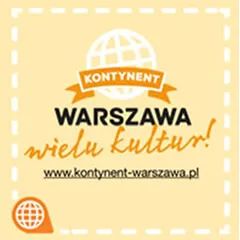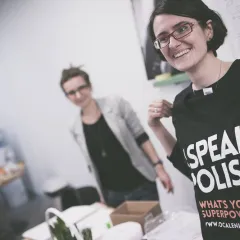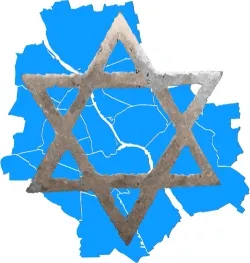- Jewish Community of Warsaw (ul. Twarda 6, www.warszawa.jewish.org.pl) has over 500 members of age and 1500 people for the benefit of whom it renders different sorts of services. The activity of the Jewish Community of Warsaw streamlines into laic work (social aid, cultural events, club for young people and seniors) and into religious doings (congregations of orthodox Jews and, since a short time, also of the conservative ones).
- For those who don’t belong but are interested in the life of the Community, especially social aid may be an interesting institution. Becoming a volunteer of social aid, one helps older generations of the community and that in turn makes an excellent opportunity to learn more about the pre-war Jewish world as well as about its war and post-war vicissitudes (This email address is being protected from spambots. You need JavaScript enabled to view it.).
- Another interesting proposal may be the Jewish choir (www.clil.pl).
- Beit Warszawa (next to the only mosque in the city) has about 140 members. It is a reformed community which almost every week organizes interesting discussions, concerts and mutual improvement groups (www.beit.org.pl).
- Chabad (ul. Słonimskiego 19/508, next to the Arkadia mall) is a department of the international orthodox organization numbering several dozen members in our country. In its work it fixes its attention on religious activities.
- The Polish Jewish Youth Organization (ZOOM) in the whole of Poland has about 200 members and is engaged mainly in work for students, in events, summer and winter camps; many a time it organizes Sabbaths and contributes to meetings with the participation of foreign groups (www.zoom.edu.pl).
- B’nei B’rith Polska is the international organization declared illegal before the war – due to its alleged freemason’s character – and recalled to being in September 2007. Abroad it does philanthropic work and battles against anti-Semitism.
- Schorr Foundation holds auto-educational lectures and Hebrew lessons (www.schorr.edu.pl).
- Polish Centre for Holocaust Research at the Warsaw University publishes, organizes discussions and carries out its own research pertaining to the extermination (www.holocaustresearch.pl).
- Otwarta Rzeczpospolita (Open Republic) fights against discrimination based on religion, nationality or skin colour (www.or.org.pl).
- The Jewish Historical Institute is an education and research institution. At the Institute there is also room for exhibitions dedicated to the Warsaw Ghetto and sacral art. The Jewish Historical Institute runs the book-shop, in which we can find historical papers on Jewish issues (www.jewishinstitute.org.pl).
Map of Jewish places in Warsaw
- Twarda 6 – here most of Jewish institutions have their headquarters.
- Synagogue – open every day from 9 am to 8 pm. The entrance fee is 6 PLN, the participation in prayers is free.
- Kosher shop – the only one in Poland; it is visited even by guests from Belorussia and the West Ukraine. Unfortunately, the prices are exaggerated and the choice rather limited.
- Bat-Buk (at Tamara’s) – the sole kosher café in Poland, situated in the basement of the White Building. The opening hours are from 12 to 7 pm. You can gossip here a little, try home-made cuisine or play billiard.
- Book Shop – in the White Building, on the 1st floor, in the editorial office of Midrasz monthly magazine there is the biggest internet Jewish book shop. In fact, it is not a real book shop and books are not placed here just like they are in a traditional book shop but you can come here to see what’s being bought. The full offer of the bookshop can be found on the website: www.midrasz.pl/_new/ksiegarnia.php.
- Sienna 55 – in the backyard there is the last remaining piece of the Ghetto wall. Next to it there is Tourist Information Point where you can get information layouts and maps of Jewish places in Warsaw as well as buy some souvenirs. The point is open from Monday to Friday, from 9 am to 7 pm
- 21 plates built in by the City Council and marking the Ghetto borders. You can find them, for example, at the cross roads of Zielna and Chłodna streets where the famous wooden-bridge stood, on the wall of the Jewish cemetery in Okopowa st. or on the square being the extension of Bohaterów Getta st. (past Nalewki) where there was one of the gates leading to the Ghetto. Some of the localizations could seem surprising however – for example the wall of the Palace of Culture and Science, at the entrance to the Studio Theatre.
- Cemetery in Okopowa is one of the greatest Jewish necropoleis in Europe with about 200 000! monuments. It is a must see place for everyone who does sightseeing in Warsaw. It can be visited from Monday to Thursday between 10 am and 5 pm (in autumn and winter till dusk), on Fridays between 9 am and 1 pm, on Sundays between 11 am and 4 pm. On Saturdays (Sabbaths) and other Jewish feast-days the cemetery is closed. The visitors are requested to pay a small fee (4 PLN). On the website www.cemetery.jewish.org.pl you can easily and quickly find friends or family members buried in the cemetery.
- Cemetery of Bródno – probably the most forgotten Jewish place in Warsaw. It is situated next to the Żaba traffic circle and it can be an example of the complicated Jewish history in our city. The cemetery was founded by king Poniatowski in 1780 and destroyed by nazists and communists, whom it served as a quarry. Monuments (macewas – gravestones) taken away to different building places, were used then in road building and in hardening runways. To the present day monuments coming from this cemetery make part of pergolas in Szypowski Park of Praga. Still many are heaped just as if they were to be loaded on trucks. There are numerous holes in the fence whereas wickets are broken away by local inhabitants who treat the cemetery as a park in which playing and walking dogs. Thus, you can enter without hitch (in order to respect the memory of the departed, gentlemen are requested to wear a head-gear).
- Monument to the Ghetto Heroes – on Bohaterów Getta square where on 19 April, 1943 first encounters between the insurgents and Germans took place.
- Miła 18 – not very high hill, commonly called the mound of Anielewicz, as a matter of fact, is the tomb made of ruins and the place of death of over 100 people. They were fighters of the Jewish Fighting Organization who, invested by Germans, committed suicide, like the legendary defenders of Masada. Here, among others, the leader of Warsaw Ghetto Uprising – Mordehaj Anielewicz died.
- Umschlagplatz – this modest monument in Stawki st. commemorates nearly 300 000 Jews who were taken away to die in Treblinka.
Culture
In Warsaw there is the Jewish Theatre (Pl. Grzybowski 12/16) at which one can see such performances as “Skrzypek na dachu” (Fiddler on the roof), “Między dniem a nocą. Dybuk” (Between night and day. Dybuk) and “Tradycja” (Tradition) – new show at the theatre. From time to time plays on Jewish issues are staged, like “Ostatni Żyd w Europie” (The last Jew in Europe), put up from the beginning of this year at the Wola Theatre. And quite often in Warsaw off-plays are put on stage by Paweł Passini nominated this year to Polityka’s Passports. Every year two competing film festivals take place: International Film Festival “Jewish Motives” and a bit less successful Warsaw Jewish Film Festival. Films that win the Festivals sometimes are commercially shown in cinemas, just as was the case with “Medusas” and “Visite de la Fanfare”. And “Beaufort”, about the war in Lebanon, was being illegally copied and bought on the 10th Anniversary Stadium.
Each year also other cyclic events take place, being celebrated by the whole community. Most often they are martyrological or religious in character (the lack of exact dates indicates the fact that those are “movable feasts”):
- January
- February
- March
Commemoration of the anti-Semitic excesses of 1968 – celebrated by the donation of flowers at the commemorating plate at the Railway Station of Gdańsk, from which Poles of Jewish origin were moving abroad.
- April
The Pesach feast – it commemorates the exodus of the Jews from ancient Egypt. During this feast we gorge ourselves on Matzah (unleavened bread).
19 April – the celebration of the Warsaw Ghetto Uprising. A group of several hundred people, in the past led by Marek Edelman, gathers at the monument of Ghetto Heroes and makes for Umschlagplatz.
At the end of the month the March of the Living takes place – young Poles together with Jews from all over the world go to Auschwitz to show that despite Holocaust they are still alive.
- May
15 May – the anniversary of Israel’s creation, celebrated with a picnic in 6 Twarda st.
June
The Shavuot Feast remembers the giving of the Torah to Moses. This night Jews all over the world gather in synagogues to study Torah
- July
- August
- September
- October
- November
Warsaw Jewish Film Festival (www.wjff.pl).
- December
In Warsaw a few editorial offices have their headquarters, for example the monthly magazine “Midrasz” and the bimonthly “Słowo Żydowskie”. They both can be bought in Empik. The offer in the internet seems rich and particularly recommendable are the following sites:
www.fzp.net.pl, www.jewish.org.pl, www.znak.org.pl – created by the cracovian Association “Znak” and information mailing list – “Wieść gminna” that gives information in Polish and sometimes in English on what’s new in the Jewish world of Warsaw. You can join the mailing list by sending a mail to: This email address is being protected from spambots. You need JavaScript enabled to view it.. Another interesting thing is the newsletter managed by the emigrants of March in Denmark (This email address is being protected from spambots. You need JavaScript enabled to view it.).
One shouldn’t either forget about the Hebraic Studio of the Polish Radio (www.polskieradio.eu/zagranica/il) – this program as only one in Europe is emitted in Hebrew.
For those who wish to learn something more about the Jewish world, there is a site managed by the Adam Mickiewicz Institute: www.diapozytyw.pl and very curious www.izrael.badacz.org while those interested in the history of Warsaw should take a look at www.warszawa.getto.pl and www.kirkuty.xip.pl – an excellent site dedicated to Jewish cemeteries in whole Poland.
How to look for roots?
Before the war in Poland there lived nearly 3 million people of Jewish nationality. This made 11% of all Polish citizens. Approximately 200 000 Jews survived the war. Many of them emigrated and others, who decided to stay, became assimilated. They were changing their names, baptizing themselves and their children, breaking up with tradition, they decided – for their safety and for the safety of their descendants – to stop being Jews. Others believed that, if Holocaust happened, God doesn’t exist. It all results in the fact that many Poles – either they know about it or not – have Jewish origins and more than a half of the Jewish Community of today was brought up in Polish, often catholic houses, in houses in which the descent of the ancestors was a carefully kept secret. Now when the war generation is passing away, children and grandchildren, amid family remembrances, discover documents indicative of Jewish origin. If you find such documents, you can learn more about the history of your family in the archives of the Jewish Historical Institute (ul. Tłomackie 3/5). There is there a special genealogical program, run by Annae Przybyszewska-Drozd (This email address is being protected from spambots. You need JavaScript enabled to view it.). You can also find useful the site www.jewish.gen.org.
Text by Jan Gebert, December 2009
Translated by Magda Torzecka






